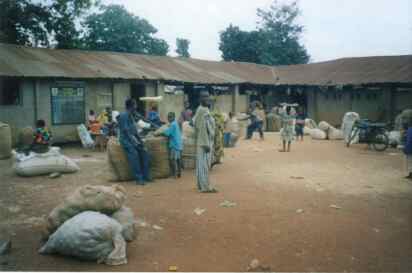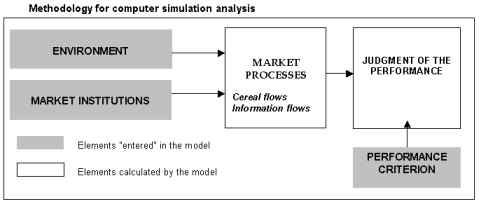|
|

|
MARKETS : Markets as communication systems
Assessing the performance of different market institutions using computer
simulations
Franck Galtier, Cirad.
The famous work by F. Hayek, L. Hurwicz, J. Stiglitz, and S. Grossman
showed that market performance depends on an ability to ensure the dissemination
of information between economic stakeholders. As information is passed
on by the processes of negotiation and trade, the type of trading network
plays a crucial role since it determines the architecture of the channels
through which information flows. Recent work has analysed this aspect
using mathematical tools (Kirman 1983; Ioannides 2002) or computer tools
(Kirman and Vriend 2000; Kerber and Saam 2001). The work described here
falls into the second category.
It involved a comparative analysis of the performance of two modes of
wholesale trade organization widely used in agricultural commodity chains
of the developing countries: network trading and marketplace trading.
Store of a wholesaler in Niono (Mali) 
These two institutions function very differently. In the case of a trading
network, each wholesaler in a consumer zone (CW) has correspondents (PW)
in the different production zones (one per zone) and, in principle, should
only procure supplies from his correspondents. Thus, when a CW wishes
to buy maize or millet, he contacts his correspondents in different locations
(usually by telephone, or by mail delivered by truckers or taxi drivers),
centralizes the sale proposals made by each of them (in terms of price,
quality, delivery date, terms of payment, etc.) and enters into transactions
with the one making the most interesting bid. The entire process of negotiation
and exchange takes place at a distance. In the case of wholesale markets,
CWs circulate in the production zones, where they meet PWs in the marketplaces
(on market day). The dissemination of information is therefore very different
in the two types of institution.
 Wholesale markets in Kétou (Bénin)
Wholesale markets in Kétou (Bénin)
Discussion on the relative performances of these two institutions has
major repercussions for public policies. Indeed, States and funding agencies
tend to favour wholesale markets, which are judged to be preferable for
ensuring market "transparency". It is this idea that we have
attempted to test here, by analysing whether any situations exist where
trading networks prove to be better communication systems than wholesale
markets.
 The
analysis was based on computer simulations using a multi-agent system
(MAS). The approach consisted in "entering" an (environment,
market institution) pair in the model, simulating the induced exchange
processes and measuring the efficacy of the resource allocation obtained
in that way (in accordance with a previously defined performance criterion).
This approach (shown in the following graph) makes it possible to test
the comparative efficacy of wholesale trading networks and wholesale markets
in different environments (to see their respective scope of relevance). The
analysis was based on computer simulations using a multi-agent system
(MAS). The approach consisted in "entering" an (environment,
market institution) pair in the model, simulating the induced exchange
processes and measuring the efficacy of the resource allocation obtained
in that way (in accordance with a previously defined performance criterion).
This approach (shown in the following graph) makes it possible to test
the comparative efficacy of wholesale trading networks and wholesale markets
in different environments (to see their respective scope of relevance).
In the scenarios performed, the environment was modelled from two
sets of variables: the degree to which the activity was concentrated on
the level of production zone wholesalers (PWs) and the variability in
supplies to those wholesalers. The market institutions represented
were trading networks and wholesale markets, along with an imaginary "perfect"
institution, i.e. one which enabled total market transparency and optimum
allocation of resources. This last institution was used as a control to
measure the efficiency of the other two. Lastly, the performance criterion
adopted was the minimization of rationing in consumption localities.
The simulations involved 150 different scenarios (50 environments and
3 market institutions). Each of the 150 scenarios was simulated over 100
time periods, approximately corresponding to two farming seasons, taking
a model time period to be a week in reality (numerous marketplaces operate
on a weekly basis). A thousand simulations were carried out for each scenario,
in order to neutralize the effect of the random variables introduced into
the model.
The main results were as follows :
- Whilst networks and wholesale markets disseminate far fewer bits of
information than the control institution, they manage to generate an
allocation of resources that is almost as good (at least when the environment
is unstable, which tallies with numerous true situations). This is confirmation
of the intuition of F. Hayek and L. Hurwicz whereby market institutions
that are relatively economical in terms of disseminating information
can lead to an efficient allocation of resources.
- The most decisive (environment) variable for the comparative performance
of the two institutions was the number of production zone wholesalers
(PWs). In fact, when there are 15 PWs, networks always prove to be more
efficient than wholesale markets, whereas the opposite is the case with
30 PWs. This result fits in with the empirical reality of the cereal
markets in Mali and Benin. Indeed, in Mali, the activity is highly concentrated
at PW level: there are only around ten per stockpiling locality. Conversely,
in Benin, this activity is covered by smaller scale PWs in larger numbers
(between 60 and 150 depending on the stockpiling localities). Yet it
is actually in Mali (where the PWs are larger scale and fewer in number)
that trading networks are found and in Benin (where PW activity is far
more scattered) that wholesale markets are found.
This result is contrary to the preconception whereby wholesale markets
are better communication systems than trading networks. This should logically
lead to a total rethink of public policies in this field (which are currently
geared towards promoting wholesale markets).
Computer modelling of market processes proved to be relevant in explaining
how an efficient allocation of resources can result from the decentralized
interactions of numerous individuals among whom the information is dispersed.
This approach thus complements other tools such as the games theory or
market experimentation [Smith 1982; Roth 2001]. Its strong points are
that it enables an analysis of market processes within which transactions
take place "out of balance" (which is difficult with the games
theory), and involves numerous stakeholders and quite long time periods
(which experiments do not allow).
This work also opens up a certain number of research prospects. One of
them consists in including elements related to the "language"
of the market institutions. Indeed, The messages (embodied in the purchase
and sale proposals of the players) are expressed according to rules that
define how the different trading parameters should be qualified (price,
quantity, quality, payment and delivery deadlines, and delivery site)
and how they should be negotiated. These rules (which constitute the "market
language") can also be assessed using computer simulations.
Bibliography
AMSELLE, J.-L. (1977). Les commerçants de la savane : histoire
et organisation sociale des Kooroko (Mali). Paris, Anthropos.
DEMBELE, N. et J. STAATZ (1989). Transparence des marchés céréaliers
et rôle de l'état: La mise en place d'un système d'information
des marchés au Mali. Séminaire European Seminar of Agricultural
Economists.
EGG, J., F. GALTIER, et E. GREGOIRE (1996). "Systèmes d'information
formels et informels - La régulation des marchés céréaliers
au Sahel." Cahiers des Sciences Humaines 32(4): 845-868.
GALTIER, F. (2002). "Eclatement et incomplétude de la théorie
des marchés" Economies et Sociétés (in press).
GROSSMAN, S. (1989). The Informational Role of Prices. Cambridge, MIT
Press
HAMADOU, S. (1997). Libéralisation du commerce des produits vivriers
au Niger et mode d'organisation des commerçants privés.
Les réseaux marchands dans le fonctionnement du système
de commercialisation des céréales. Economics PhD thesis,
Montpellier, ENSA.M.
HAYEK, F. (1945). "The Use of Knowledge in Society", American
Economic Review 35(4): 519-530.
HURWICZ, L. (1969). "Centralization and Decentralization in economic
systems - On the Concept and Possibility of Informational Decentralization",
American Economic Review 59: 513-524.
IOANNIDES, Y. (2002). "Topologies of Social Interactions", Departement
of economics, Tufts University.
KERBER, W. and N. SAAM (2001)."Competition as a Test of Hypotheses:
Simulation of Knowledge-generating Market Processes", Journal of
Artificial Societies and Social Simulation 4(3).
KIRMAN, A. (1983). "Communication in Markets: A Suggested Approach",
Economic Letters 12: 1-5.
KIRMAN, A. and N. J. VRIEND (2000). "Evolving Market Structure: An
ACE Model of Price Dispersion and Loyalty", Journal of Economic Dynamics
and Control (ACE Special Issue).
LAMBERT, A. et J. EGG (1994). "Commerce, réseaux et marchés
: l'approvisionnement en riz dans les pays de l'espace sénégambien."
Cahiers des Sciences Humaines 30: 229-254.
LE PAGE, C., F. BOUSQUET, et al. (2000). CORMAS: A multiagent simulation
toolkit to model natural and social dynamics at multiple scales. Workshop
"The ecology of scales", Wageningen (Netherlands).
ROTH, A. (2001). "The Economist as Engineer: Game Theory, Experimentation,
and Computation as Tools for Design Economics" Econometrica 70(4):
1341-1378.
SMITH, V. (1982). "Markets as economizers of information: experimental
examination of the "Hayek hypothesis", Economic Inquiry 20:
165-179.
For further information, contact the
author or download the model (Cormas2003): markets
References
...soon !
|
|

